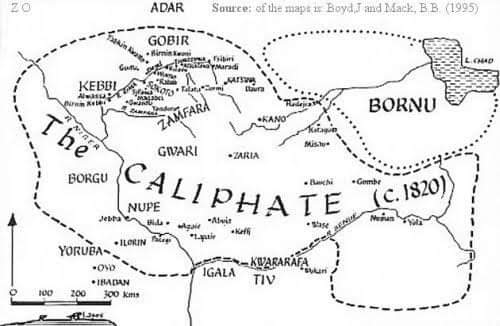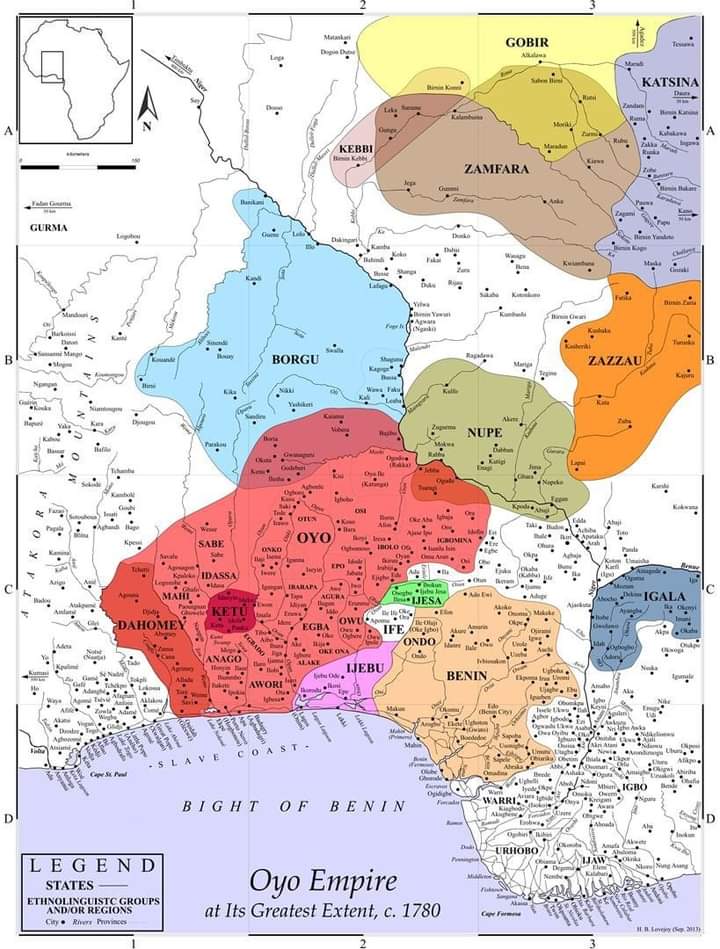
The recent campaign for the independence of the Yoruba Nation has sparked some debates on the history of Ilorin. The ancient city, ruled by an Emir, with diverse cultures has been a subject of discourse. Recently, an Islamic Cleric, Sheikh Habeeb al-Ilori, while speaking to an audience argued that Ilorin does not belong to the Yorubas. For the records, this piece aims to correct some misconceptions and distortion of history and not to support any form of ethnic supremacy, bigotry or religious agenda.
Sheikh Habeeb, in a now viral video, asked, “How is Ilorin a Yoruba land? Except one is mischievous, the question of whether Ilorin belongs to the Yorubas should not be a subject of debate. One of the most authoritative work on Yoruba history is Samuel Johnson’s, “The History of the Yorubas” (1929). Others include, “The Origin of the Yoruba”, by Saburi Biobaku (1955), and “A Brief History of the Yorubas”, by Bishop Ajayi Crowther (1843). This piece shall rely on Samuel Johnson’s, “The History of the Yorubas”, Ibraheem Sulaiman’s, “The African Caliphate: The Life, Works & Teachings of Shaykh Usman Dan Fodio” (2009) and a tour of the Sokoto Caliphate as a research work on “Sheu Usman Dan Fodio and the Rise of the Sokoto Caliphate” by Bashir Lucas Samson Lukman (2020). The author challenges Sheikh Habeeb to provide the source(s) of his history.
Indeed, history may cry for justice if we neglect some key events that birthed this topic of discourse. Not only is it necessary to talk about Oba Aole, during whose reign, the Oyo Kingdom lost its glory and Afonja, that brave and restless warlord, who led the revolution, we cannot boast of being fair if we do not mention Sheu Dan Fodio and his Jihad that led to the invasion of Ilorin as well as Alimi, that priest whose name will never be forgotten.
Afonja, a native of Ilorin was a fearless, brave and restless warlord. Afonja was the son of Alagbin, the son of Pasin, the son of Laderin. It was Laderin who built the city of Ilorin, ruled and passed down the government till it got to Afonja till the Fulani invasion. Afonja’s ascension to the post of Aare Ona Kakanfo (the highest military title of the Oyo Empire) after the death of Kakanfo Oyabi in a way of force set him against Oba Aole (the Alaafin of Oyo). One may ask, “If Ilorin was not a Yoruba land, why is Afonja of Ilorin the kakanfo of the Oyo Empire?”
Oba Aole had not forgiven Afonja but did not want to cause a civil war. As it was the norm, the Alaafin sends the military on expeditions. Though reluctant, as he would say, “I have told you that my enemy is too formidable for me, and besides we are the same kith and kin”, Oba Aole eventually succumbed to pressure from his counselors and devised a way to deal with Afonja. The Alaafin sent Kakanfo and the army to Iwere, an impregnable town that has been forbidden to be attacked by any Oyo warrior. To be brief, the Kakanfo discovered the plot and the army massacred the royal party. This began the revolution that tore the Oyo Empire apart. We shall take a pause here and go to the events that gave birth to the Sokoto Caliphate. It should be noted that before this revolution, no Fulani Emir ruled in Ilorin.
Sheu Usman Dan Fodio was born in the Maratta, now in Niger Republic, on the 15th of December, 1754 to Muhammad ibn Salih (widely known as Fodio) and his mother, Hawwa bint Muhammad ibn Usman. Much has been said regarding the Jihad of Dan Fodio. Some have argued that it was a tribal war while some non-Muslims have unnecessarily included themselves amongst the victims of the Jihad. What is obtainable is that Dan Fodio was an Islamic reformer. We will discuss the background to the Jihad and how Ilorin became an Emirate.
In the 17th century Hausaland before the emergence of Sheikh Dan Fodio, pristine Islam was at a decline. Despite being a Muslim society, there was an open and unrestricted disregard for the laws of Allah. Immorality was the order of the day; there was an unrestrained mixing of men and women, cheating and fraud became a norm. Against the teachings of Islam, women were oppressed and relegated. The then Hausaland was at a very critical stage in history that the Shariah was altered to favour the governing minority. These were what Sheikh Uthman Dan Fodio sought to correct. To bring Islam back to its normal state in the land providing an alternative moral, intellectual, and political leadership based on the pristine teachings of Islam. In his own method, all Muslim communities must be under Amir al-Muminin. Whoever distanced himself among the Amirs should be invited to pledge their allegiance and if they refuse to do so, they should be fought until they submit to the Amir. At its greatest extent, the Sokoto Caliphate Kebbi, Zamfara, Katsina, Zazzau, Daura, Kano, Gombe, Ilorin, Nupe, Bauchi, Adamawa, Katagun, etc. Let us go back to the Oyo Empire.
Afonja, along with other rebel Chiefs, sent an empty calabash to the King, Aole, meaning that he was rejected and must commit suicide. Following the death of the King, Afonja of Ilorin and Opele, the Baale of Gbogun declared independence. It was Afonja’s ambition to strengthen his own hands that led him to employ the services of Sheu Alimi and his Hausa slaves. These slaves who did menial jobs were recruited into the army. He, Afonja, also invited his rich and powerful Yoruba friend, Solagberu who lived at the outskirts of Ilorin. More Muslims came from Gbanda, Kobayi, Agoho, Kuwo, and Kobe and camped under Solagberu. Oke Sunna (The Quarter of the Faithful), which is still in Ilorin today, was the name given to where they camped. We can ask Sheikh Habeeb to tell us the history of Oke Sunna in Ilorin.
The slaves-turned-soldiers came with the excesses. To be brief, we will not go into details as to the excesses of the Alimi’s boys under Afonja’s army as well as the wars they fought for Afonja. The excesses of these soldiers called the Jamas became much that Afonja resolved to disband them, thus, the beginning of the fall of Ilorin into the hands of the Fulanis. Afonja had written Onikoyi and others to help him annihilate the Jamas who got wind of the Afonja’s aim and rose up against him. Samuel Johnson had, in his book, focused on the Yorubas and probably had no idea about the spread of the Sokoto Caliphate or omitted it because it was not relevant to his book. The truth is, Ilorin was not amongst the agenda of Sheu Usman Dan Fodio. It was the treachery, supremacy, envy, greed of the Yorubas, especially the ego of Afonja that led to the loss of Ilorin to the Fulanis.
The Sokoto Caliphate has 18 Flagbearers. These flagbearers receive the flag from Sheu Dan Fodio meaning these places the flags are sent to have become a part of the Caliphate. Historians of the Sokoto Caliphate will mention one Alimi from Ilorin who had requested for a flag. It was Abudusalami, Sheu Alimi’s son who became the first Emir of Ilorin. Sheu Dan Fodio’s letters can be found at Gidan Tairi in Sokoto. These are letters he wrote to some Muslim Kings asking them to turn to pristine Islam, offering peace or war. No letter was written to any Muslim King in Ilorin and no Emir ruled in Ilorin until after the death of Afonja.
As it was the norm then, the Fulani soldiers advanced, aimed to extend their territories, just like the Oyo Empire till they were stopped in Osogbo by Ibadan Soldiers. Kabbi, Zamfara, Katsina, Zazzau, Daura, Kano, Gombe, Ilorin, Nupe, Bauchi, Adamawa, Katagun, Hadejia, Kazaure, Misau, Jama ‘Are, Kaura Namoda and Ya’ndota all had individuals who received flags from Sheu Dan Fodio. We may ask Sheikh Habeeb how Dan Fodio and Alimi founded Ilorin, a city with a Yoruba name, surrounded by Yoruba towns.
It also should be noted that Islam had been in Yoruba Land before the birth of Sheu Uthman Dan Fodio, therefore, it was not the Jihad that brought Islam to the Yorubas. It also should be understood that were it not for Afonja and the revolution, the Jihad of Dan Fodio should have had nothing to do with Ilorin nor shall we have to debate the ownership of city.
The author also wishes to state that expansion of territories was the order of the day, hence, any resentment against the Fulani man in the 21st century for the invasion of Ilorin should be buried. The Oyo empire, the British, Napoleon, Alexander the Great are all guilty of what those who invaded Ilorin could be accused of.
Lastly, the author seeks to clear some misconceptions surrounding the history of Ilorin and to refute distortion of history by Sheikh Habeeb al-Ilory. The author shall not be responsible for whatever is done with the information contained in this piece.
Attached is a 1780 map of the Oyo empire when Ilorin was in the Oyo Empire and an 1820 map when Ilorin had fallen under the Sokoto Caliphate.


Bashir Lucas Samson Lukman writes in from Lagos.
PS: The views, thoughts, and opinions expressed in the text belong solely to the author, and not necessarily that of the Publishers of The Precision NG.















